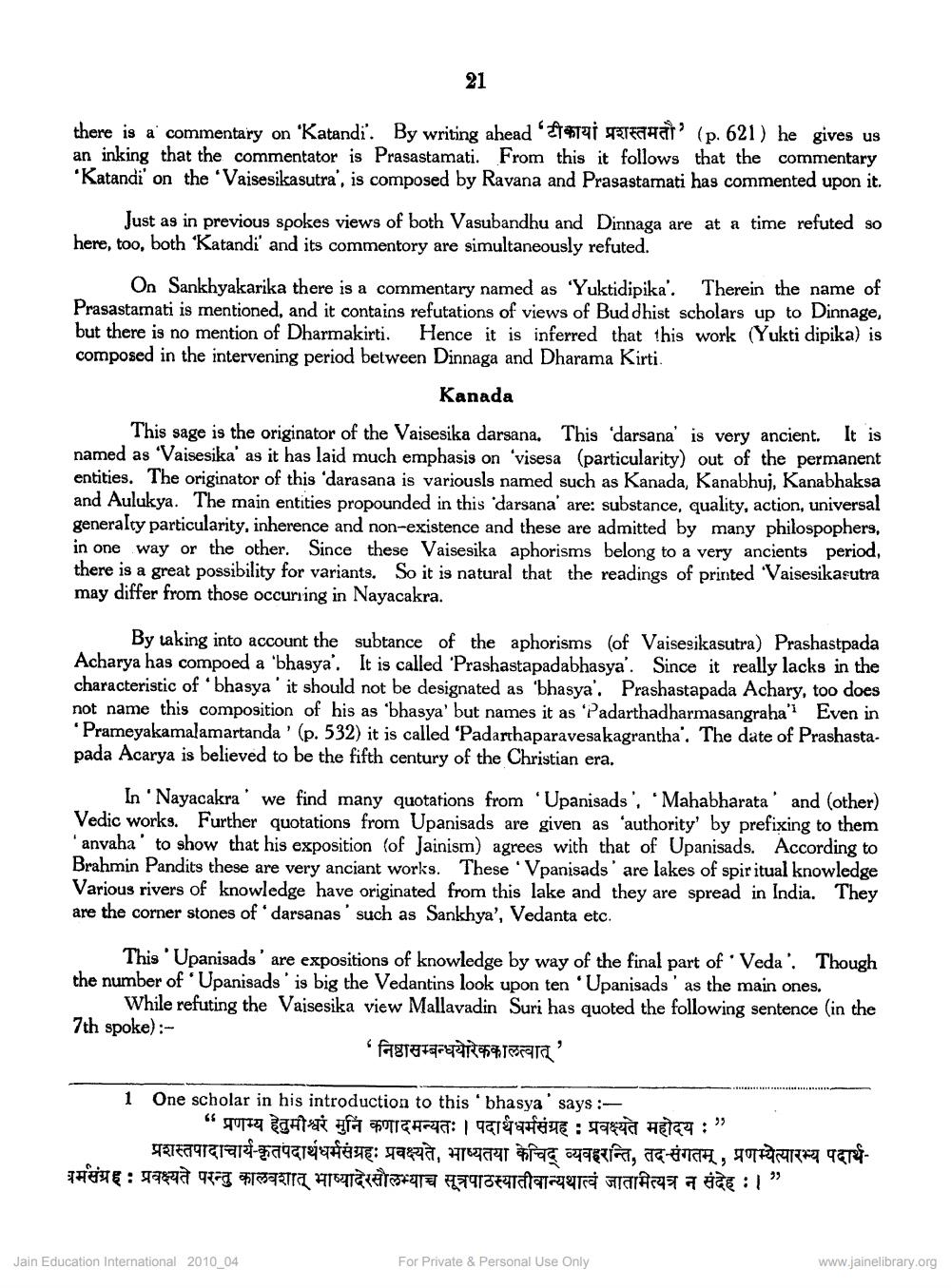________________
there is a commentary on 'Katandi. By writing ahead 9 91 Prahat (p. 621) he gives us an inking that the commentator is Prasastamati. From this it follows that the commentary 'Ratandi' on the 'Vaisesikasutra', is composed by Ravana and Prasastamati has commented upon it.
Just as in previous spokes views of both Vasubandhu and Dinnaga are at a time refuted so here, too, both Katandi' and its commentory are simultaneously refuted.
On Sankhyakarika there is a commentary named as 'Yuktidipika'. Therein the name of Prasastamati is mentioned, and it contains refutations of views of Buddhist scholars up to Dinnage, but there is no mention of Dharmakirti. Hence it is inferred that this work (Yukti dipika) is composed in the intervening period between Dinnaga and Dharama Kirti.
Kanada This sage is the originator of the Vaisesika darsana. This 'darsana' is very ancient. It is named as "Vaisesika' as it has laid much emphasis on 'visesa (particularity) out of the permanent entities. The originator of this darasana is variousls named such as Kanada, Kanabhuj, Kanabhaksa and Aulukya. The main entities propounded in this darsana' are: substance, quality, action, universal generally particularity, inherence and non-existence and these are admitted by many philospophers, in one way or the other. Since these Vaisesika aphorisms belong to a very ancients period, there is a great possibility for variants. So it is natural that the readings of printed Vaisesikasutra may differ from those occurring in Nayacakra.
By taking into account the subtance of the aphorisms (of Vaisesikasutra) Prashastpada Acharya has compoed a 'bhasya'. It is called 'Prashastapadabhasya'. Since it really lacks in the characteristic of 'bhasya' it should not be designated as 'bhasya'. Prashastapada Achary, too does not name this composition of his as 'bhasya' but names it as Padarthadharmasangraha" Even in 'Prameyakamalamartanda ' (p. 532) it is called 'Padarthaparavesakagrantha'. The date of Prashastapada Acarya is believed to be the fifth century of the Christian era.
In 'Nayacakra' we find many quotations from 'Upanisads: Mahabharata' and (other) Vedic works. Further quotations from Upanisads are given as `authority' by prefixing to them 'anvaha' to show that his exposition (of Jainism) agrees with that of Upanisads. According to Brahmin Pandits these are very anciant works. These · Vpanisads' are lakes of spiritual knowledge Various rivers of knowledge have originated from this lake and they are spread in India. They are the corner stones of darsanas' such as Sankhya', Vedanta etc.
This 'Upanisads' are expositions of knowledge by way of the final part of Veda'. Though the number of Upanisads' is big the Vedantins look upon ten 'Upanisads' as the main ones.
While refuting the Vaisesika view Mallavadin Suri has quoted the following sentence in the 7th spoke):
'निष्ठासम्बन्धयोरेककालत्वात् '
1 One scholar in his introduction to this 'bhasya' says :
"प्रणम्य हेतुमीश्वरं मुनि कणादमन्यतः। पदार्थधर्मसंग्रह : प्रवक्ष्यते महोदय:"
प्रशस्तपादाचार्य-कृतपदार्थधर्मसंग्रहः प्रवक्ष्यते, भाष्यतया केचिद व्यवहरन्ति, तद-संगतम् , प्रणम्येत्यारभ्य पदार्थधर्मसंग्रह: प्रवक्ष्यते परन्तु कालवशात् भाष्यादेरसौलभ्याच सूत्रपाठस्यातीवान्यथात्वं जातामत्यत्र न संदेह:।"
Jain Education International 2010_04
For Private & Personal Use Only
www.jainelibrary.org




